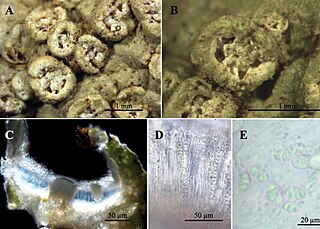
The Graphidaceae are a family of lichen-forming fungi in the order Graphidales. The family contains nearly a hundred genera and more than 2000 species. Although the family has a cosmopolitan distribution, most Graphidaceae species occur in tropical regions, and typically grow on bark.

Nadvornikia is a genus of lichen-forming fungi in the family Graphidaceae. Species in the genus are corticolous (bark-dwelling) and crustose.
Aderkomyces thailandicus is a species of corticolous (bark-dwelling), crustose lichen in the family Gomphillaceae. Found in the lower montane rainforests of Thailand, it was described as new to science in 2011.
Graphis marusae is a species of corticolous (bark-dwelling) crustose lichen in the family Graphidaceae. It is found in a relict tropical lowland rainforest in Veracruz, Mexico, growing in exposed understory.
Myriochapsa is a genus of corticolous (bark-dwelling), crustose lichens in the subfamily Graphidoidae of the family Graphidaceae. It has three species. The genus was circumscribed in 2013 by Marcela Cáceres, Robert Lücking, and H. Thorsten Lumbsch, with the Brazilian Myriochapsa psoromica assigned as the type species. The generic name combines Myriotrema and Chapsa, referring to the two Graphidaceae genera that it resembles. The main distinguishing characteristics of the new genus are its densely corticate thallus, and the presence of the lichen product psoromic acid. Additionally, its apothecia have wider pores, with differently textured margins. Although originally created as a monotypic genus, Harrie Sipman added two South American species in 2014.
Clandestinotrema is a genus of lichen-forming fungi in the family Graphidaceae. It has 17 species. They typically inhabit montane and cloud forest at higher elevations in the tropics.
Asteristion is a genus of lichen-forming fungi in the family Graphidaceae. It has seven species. Previously considered a synonym of either Phaeotrema or Thelotrema, molecular evidence led to its resurrection as a distinct genus. Asteristion lichens are corticolous (bark-dwelling), featuring a continuous thallus with a loose to hardened cortex and a photobiont layer containing calcium oxalate crystals. The ascomata, or fruiting bodies, are characterized by their large, often chroodiscoid appearance and the presence of distinct periphysoids. The secondary chemistry of these lichens includes major concentrations of stictic acid and minor to trace amounts of associated substances.
Xalocoa is a single-species fungal genus in the family Graphidaceae. The genus was circumscribed in 2013 by lichenologists Ekaphan Kraichak, Robert Lücking, and H. Thorsten Lumbsch. It contains Xalocoa ocellata, a corticolous (bark-dwelling), crustose lichen that was originally described by Elias Magnus Fries in 1831.
Gintarasia is a genus of lichen-forming fungi in the family Graphidaceae. It has seven species, all of which are found in Australia. Gintarasia species are corticolous (bark-dwelling), crustose lichens with a thelotremoid form.
Cruentotrema amazonum is a little-known species of script lichen in the family Graphidaceae. It is found in Brazil, Thailand, and Vietnam, where it grows in the understory of primary rainforests.
Clandestinotrema portoricense is a rare species of corticolous (bark-dwelling) crustose lichen in the family Graphidaceae. Found in Puerto Rico, it was described as a new species in 2014. It is characterised by its white, slightly shiny thallus that can span several centimetres in diameter, and its rounded ascomata that are immersed in the thallus. Unlike most of its genus counterparts, C. portoricense possesses septated (partitioned) spores and a carbonised (blackened) excipulum and columella, effectively distinguishing it from similar species.
Ocellularia portoricensis is a rare species of corticolous (bark-dwelling) crustose lichen in the family Graphidaceae. It was discovered in Puerto Rico, where it grows on tree trunks within shadowy understories of specific forests. This organism is distinct from other related lichens by its unique characteristics such as a white medulla and relatively larger, brown-tinted ascospores.
Allographa anguilliradians is a species of corticolous (bark-dwelling), crustose lichen in the family Graphidaceae. It has been found in Trinidad and Tobago and Central-West Brazil. Its thallus covers an area of 3 to 7 cm in diameter with a slim profile and a variable surface texture, with a distinct metallic pale grey-olive colour without a prothallus. Its reproductive structures, known as lirellae, form a star-like pattern with black, carbonised outer layers and clear, colourless hymenium, while its ascospores are oblong and segmented, reacting violet-blue to iodine-based stains.
Ocellularia vizcayensis is a rare species of corticolous (bark-dwelling) lichen in the family Graphidaceae. It is known from a single collection made in Luzon, Philippines. The lichen thallus is a white, irregularly structured, areolate surface with a layer that includes a photosynthetic partner, both containing large calcium oxalate crystals. Its fruiting bodies are either embedded or protruding, round, with very narrow openings, and contain large, oblong, colorless spores that turn violet-blue when stained with iodine.
Nitidochapsa is a genus of lichen-forming fungi in the family Graphidaceae. It has five species of corticolous (bark-dwelling), crustose lichens.

Glaucotrema is a genus of lichen-forming fungi in the family Graphidaceae. It has five species.
Crutarndina is a monotypic fungal genus in the family Graphidaceae. It contains the single species Crutarndina petractoides, a corticolous (bark-dwelling), crustose lichen.
Pseudotopeliopsis is a genus of lichen-forming fungi in the family Graphidaceae. It has two species.
Byssotrema is a monotypic fungal genus in the subfamily Graphidoideae of the family Graphidaceae. It contains the single species Byssotrema mirabile, a little-known corticolous (bark-dwelling), crustose lichen found only in Brazil.
Corticorygma is a monotypic fungal genus in the subfamily Graphidoideae of the family Graphidaceae. It contains a single species, the corticolous (bark-dwelling) crustose lichen Corticorygma stellatum. This script lichen is found in the shaded understory of rainforests in the Brazilian states of Rondônia and Paraná.



